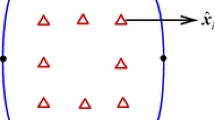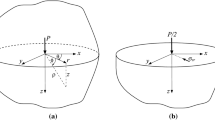Summary
A new boundary element method (BEM) formulation for planar problems of linear elasticity has been proposed recently [6]. This formulation uses a kernel which has a weaker singularity relative to the corresponding kernel in the standard formulation. The most important advantage of the new formulation, relative to the standard one, is that it delivers stresses accurately at internal points that are extremely close to the boundary of a body. A corresponding BEM formulation for three dimensional problems of linear elasticity is presented in this paper. This formulation is derived through the use of Stokes' theorem and has kernels which are only 1/r singular (wherer is the distance between a source and a field point) for the displacement equation. The standard BEM formulation for three-dimensional elasticity problems has a kernel which is 1/r 2 singular.
Similar content being viewed by others
References
Mukherjee, S.: Boundary element methods in creep and fracture. Barking, Essex, U.K.: Elsevier Applied Science Publishers 1982.
Banerjee, P. K., Butterfield, R.: Boundary element methods in engineering science. Maidenhead, Berkshire, U.K.: McGraw Hill 1981.
Brebbia, C. A., Telles, J. C. F., Wrobel, L. C.: Boundary element techniques—Theory and applications in engineering. Berlin, Heidelberg: Springer 1984.
Rizzo, F. J.: An integral equation approach to boundary value problems of classical elastostatics. Quarterly of Applied Mathematics25, 83–95 (1967).
Cruse, T. A.: Numerical solutions in three-dimensional elastostatics. International Journal of Solids and Structures5, 1259–1274 (1969).
Ghosh, N., Rajiyah, H., Ghosh, S., Mukherjee, S.: A new boundary element method formulation for linear elasticity. ASME Journal of Applied Mechanics53, 69–76 (1986).
Hager, W. W.: Computing, Vol. 1, Applied numerical linear algebra: Prentice Hall 1986 (expected).
Calderon, A. P., Zygmund, A.: On the existence of certain singular integrals. Acta Mathematica88, 85–139 (1952).
Author information
Authors and Affiliations
Additional information
With 2 Figures
Rights and permissions
About this article
Cite this article
Ghosh, N., Mukherjee, S. A new boundary element method formulation for three dimensional problems in linear elasticity. Acta Mechanica 67, 107–119 (1987). https://doi.org/10.1007/BF01182125
Received:
Issue Date:
DOI: https://doi.org/10.1007/BF01182125




